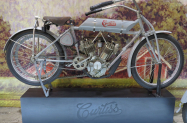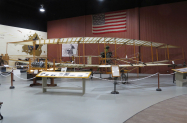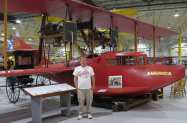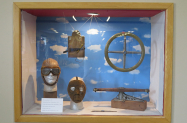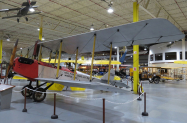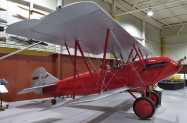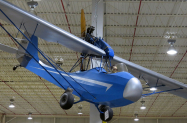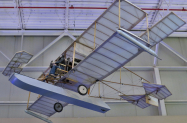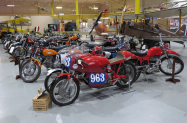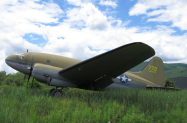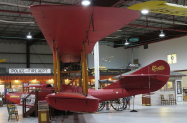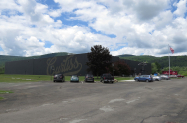The Glenn H. Curtiss Museum And The Life Of An American Aviation Pioneer

Curtiss JN-4 Jenny trainer
Story and photos by Corey Beitler
Located in the scenic Finger Lakes Region of Western New York near the town of Hammondsport, the Glenn H. Curtiss Museum is a transportation museum that honors the life and achievements of the early engine expert and motorcycle and aviation pioneer. The museum was founded in 1962 by Hammondsport resident Otto Kohl to honor the man often referred to as “Hammondsport’s Favorite Son”. Initially located in a former high school in Hammondsport, the museum moved to its current location, a facility that was a former winery, in 1992. The current location near where Curtiss flight tested many of his aircraft designs. The museum has a collection of over 20 authentic and reproduction historic aircraft, aero engines, aviation memorabilia, and vintage automobiles, motorcycles, and bicycles. The museum facility also includes a restoration shop, a 75-seat theater that shows an hour-long film that chronicles the life of Glenn Curtiss, and a museum store.
Glenn Hammond Curtiss was born in 1878 in Hammondsport, New York. Although his formal education only extended to eighth grade, Curtiss showed an early interest in mechanics and inventions. His first job was at the Eastman Dry Plate & Film Company (later Eastman Kodak) in Rochester. During his time with the company, Curtiss developed a way to speed up the stenciling process by designing and building a machine that could stencil 100 paper strips at a time with a single brush stroke. The machine improved production output and worker efficiency and was adopted by the company on its factory floor. Curtiss also used his experience at the company to develop a rudimentary camera to study photography and document the design process of his inventions. In 1896, Curtiss married his wife, Lena, also from Hammondsport, and the couple would have two children.
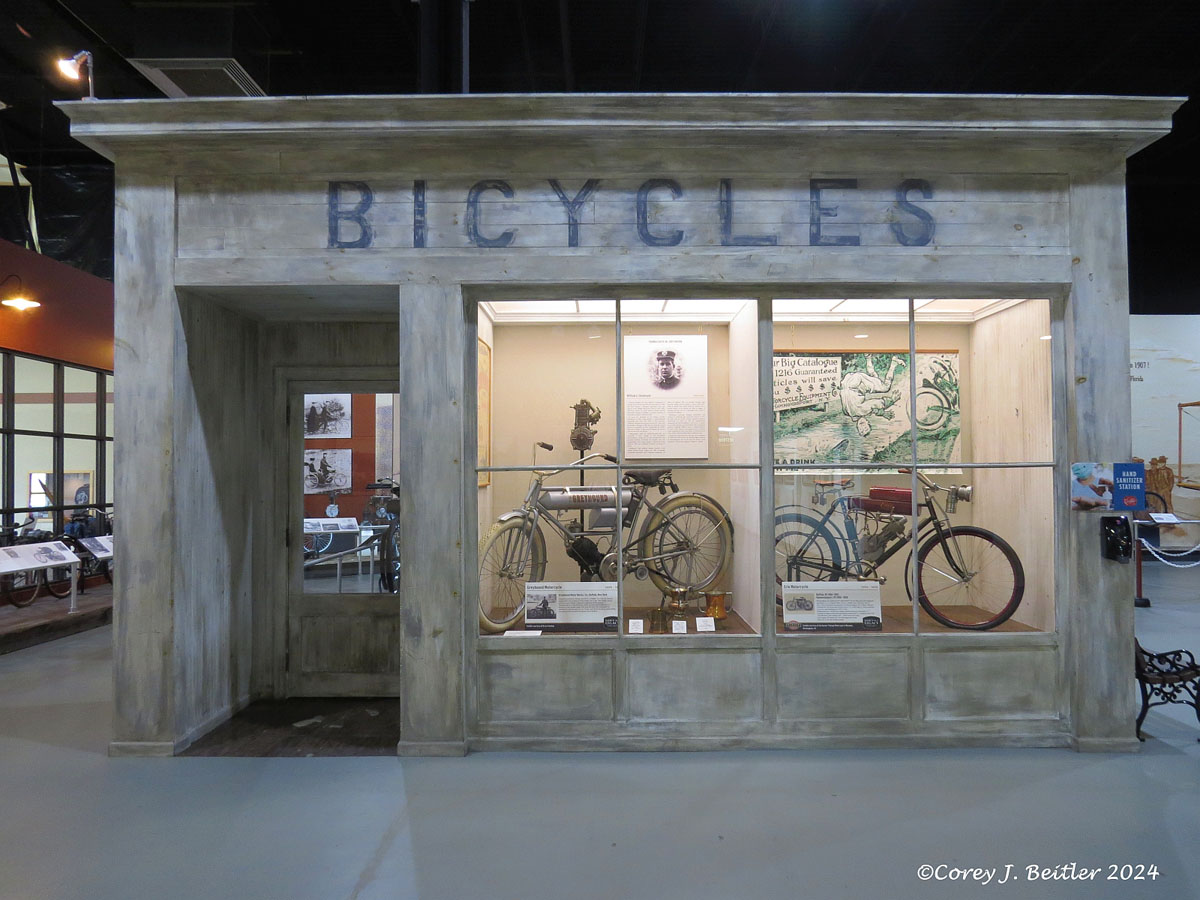
Bicycle Shop replica
After using bicycles to commute between Hammondsport and Rochester, Curtiss became interested in bicycles and began his career in the industry as a bicycle messenger for Western Union. Curtiss constantly tinkered with his bicycles to make them faster and began racing bicycles in his spare time. Eventually, with the help of several other local bicycle builders, Curtiss started designing his own bicycles and opened a bicycle shop. As the availability of internal combustion engines increased in the early 1900s, Curtiss, fascinated with speed and making transportation easier, shifted his interest from bicycles to motorcycles.

Curtiss V-8 motorcycle
In 1902, Curtiss started manufacturing motorcycles with a two-cylinder engine of his own design. In 1903, driving a motorcycle he designed, Curtiss set a land speed record of 64 miles per hour. A few years later, on January 24, 1907, at Ormond Beach, Florida, Curtiss set an unofficial world speed record of 136.36 miles per hour driving a motorcycle powered by a 40-horsepower V-8 engine of his own design. In response to the achievement, newspapers gave Curtiss the title “The Fastest Man On Earth” and he became famous worldwide. This speed record stood until 1911 and stood for motorcycles until 1930.
Curtiss’ successful racing efforts strengthened his reputation as a legendary builder of motorcycles and engines. Some of the most experienced motorcycle racers in the world traveled to Hammondsport to visit the Curtiss shop and see his designs in person. Curtiss soon began manufacturing motorcycles and engines for racers and enthusiasts. In addition to motorcycles and engines, Curtiss also manufactured components for his engines such as batteries, carburetors, spark plugs, and lubricants. The successes of Curtiss caught the attention of Alexander Graham Bell, who regarded Curtiss as one of the nation’s premiere experts in the design of internal combustion engines.

Curtiss June Bug reproduction
In 1907, Bell invited Curtiss to become part of the Aerial Experiment Association (AEA) and to help develop a suitable engine for heavier-than-air flight. Between 1909-1910, the AEA produced and experimented with four aircraft. Curtiss designed the AEA’s third aircraft, Aerodrome #3, named the June Bug, and became its test pilot. On July 4, 1908, Curtiss flew the June Bug a distance of 5,080 feet to win the Scientific American Trophy and a $2,500 prize. In 1911, Curtiss received U.S. Pilot’s License #1 from the Aero Club of America. After disagreements with the AEA, Curtiss left the organization to design aircraft on his own. Before leaving the organization, Curtiss offered to purchase the June Bug, and the AEA accepted the offer. Curtiss would use the June Bug as a basis for his series of pusher aircraft of his own design.
With help from the Aero Club of America and A.M. Herring, Curtiss founded the Herring-Curtiss Company in Hammondsport in 1909 to design and build his aircraft. Over the next two years, Curtiss took his aircraft across North America to introduce aviation to the curious American public. Many of these demonstrations took place in front of thousands of people at state and county fairs and carnivals. So Curtiss could showcase his aircraft to as many people as possible, he hired several pilots to fly demonstrations across the country. Some of these pilots included Charles K. Hamilton, J.A.D. McCurdy, and Augustus Post.

Curtiss Pusher
The pusher aircraft designed by Curtiss during this period had several innovative design features, one of the most significant being ailerons as a control surface. Unlike wing warping, which many other airplanes of the era relied on for lateral control, ailerons provided more control and improved maneuverability. These ailerons were controlled by a shoulder yoke system, and the pilot leaned which way he wanted to turn the airplane, similar to that of a driver of a motorcycle leaning while driving in turns. Rudder movements on early Curtiss pusher aircraft were controlled by a steering wheel, similar to an automobile. Unlike other early aircraft, which used skids for landing gear that often got damaged on a rough landing, Curtiss aircraft pioneered using of wheels and rubber tires. For the era in which they were designed, the engines that powered Curtiss aircraft were reliable and more powerful than other aero engines. Finally, with the engine in a pusher configuration behind the pilot, the pilot had excellent visibility for flying the aircraft.
In 1909, Curtiss was invited to take part in an aviation meet in Reims, France organized by the Aero-Club de France. On August 28, 1909, Curtiss won the Gordon Bennett Cup, the overall speed event at the exhibition. Curtiss completed the 12.5-mile course in just under 16 minutes with a top speed of over 40 miles per hour. The performance of Curtiss and his pusher aircraft at the event drew the envy of many of the European pilots at the event. Returning home, Curtiss was invited to fly in an event called the Hudson Fulton Celebration in New York City. The Wright Brothers were invited to fly in the event too, and Wilbur Wright flew one of the Wright Flyer aircraft. Over the course of a week, the two rivals flew together and demonstrated their machines to the public. It was one of the few times Glenn Curtiss and the Wright Brothers professionally interacted with each other at an aviation exhibition.
Unfortunately, lawsuits and a patent war that began in 1909 ultimately created a heated competitive rivalry between the Wright Brothers and Glenn Curtiss that grew deeply personal. The two parties spent so much time fighting with each other in court that aviation progress in the United States fell way behind that of European countries. This only became apparent when World War I began and the U.S. military found their aircraft to be significantly inferior to European designs. Eventually, the U.S. Government pressured both parties to resolve their disputes to prioritize the country’s aviation needs. The rivalry also changed the way the men approached designing their aircraft. Fearing others would copy their designs and occupied by their lawsuits, the Wright Brothers offered little innovation as they designed new versions of their Flyer aircraft. By comparison, Curtiss continued to improve and innovate his aircraft, experimenting with new ideas and designing aircraft for practical needs. In this regard, Glenn Curtiss did much more to develop practical aircraft than the Wright Brothers.
The controversy between Glenn Curtiss and the Wright Brothers did not stop with lawsuits and court proceedings. Curtiss and the head of the Smithsonian Institution, Charles Walcott, tried to restore the reputation of Samuel Langley, who had failed at his attempt at powered flight. Curtiss extensively modified Langley’s 1903 aircraft in secret, and in 1914, demonstrated it could fly. Walcott and the Smithsonian Institution then endorsed the statement that Langley’s 1903 Aerodrome was the first man-carrying aircraft capable of flight. To cover up the deception and the fact Curtiss had made 45 modifications to the aircraft, Walcott ordered Curtiss to return Langley’s Aerodrome to its original configuration before going on display in the museum. The decision of the Smithsonian Institution infuriated Orville Wright, so much so that he donated the Wright Flyer to the London Science Museum. In 1928, the Smithsonian Institution Board of Regents reversed its endorsement of Langley and stated the Wright Brothers deserved credit for the first flight. An official retraction of the false credit and official correction of the Smithsonian Institution record to give the Wright Brothers and their Flyer credit for the first flight was published in 1942. The Wright Flyer remained on display in the London Science Museum until 1948, when after several letters between Orville Wright and the new Secretary of the Smithsonian Institution Charles Abbot, Orville agreed to return the Wright Flyer to the Smithsonian Institution for display in a place of honor it deserved.

Curtiss Model 16 Flyng Boat
Following his success in France and at the exhibition in New York City, the fame continued for Glenn Curtiss and his aircraft. On May 29, 1910, Curtiss flew one of his pusher aircraft from Albany to New York City to make the first long-distance flight between two cities in the United States. Curtiss completed the 137-mile flight in just under four hours, including one refueling stop. For this flight, Curtiss was awarded a $10,000 prize by publisher Joseph Pulitzer and permanent possession of the Scientific American Trophy.
The success of Curtiss and his aircraft caught the attention of the U.S. Navy, which was interested in determining the feasibility of aircraft taking off and landing on ships. On November 14, 1910, Curtiss test pilot Eugene Ely successfully took off from a temporary wooden platform installed on the U.S.S. Birmingham. By the end of the year, Curtiss was training Army and Navy personnel to fly his aircraft at an encampment in San Diego. Throughout that winter, Curtiss was also hard at work on another project, developing a wooden float that enabled his aircraft to take off and land on water. Curtiss surmised, and correctly so, that aircraft that could take off and land on water would be useful where large bodies of water dominated the landscape, such as the Finger Lakes Region where he was from.
In January 1911, Curtiss flew the first seaplane from a body of water in the United States. Also that year, Eugene Ely became the first pilot to successfully land on a ship when he landed his Curtiss Pusher on a raised platform aboard the battleship U.S.S. Pennsylvania. The aircraft was stopped upon landing by a system of cables arrested to the landing surface. This was the first use of a cable-arrested landing system on a ship and the prelude to aircraft carrier operations. These flights led to a long and successful collaborative relationship between Curtiss, his company, and the U.S. Navy.

Curtiss A-1 Triad model
Later in 1911, Curtiss built an aircraft called the A-1 Triad. The Triad was a seaplane but was also equipped with retractable wheels so it could land and take off from land as well, making it the first amphibious aircraft ever built. By designing an aircraft that could be used almost anywhere, Curtiss was awarded the Collier Trophy. The U.S. Navy recognized the usefulness of the A-1 Triad immediately and purchased several examples of the aircraft. Later, Japan, Germany, Great Britain, and Russia all purchased examples of the A-1 Triad. The success of Glenn Curtiss as an aircraft designer and his aircraft like the A-1 Triad during this time would not have been possible without Henry Klecker. Klecker was Curtiss’ “right-hand man” and worked with him to design efficient and reliable engines for the aircraft Curtiss designed and built.
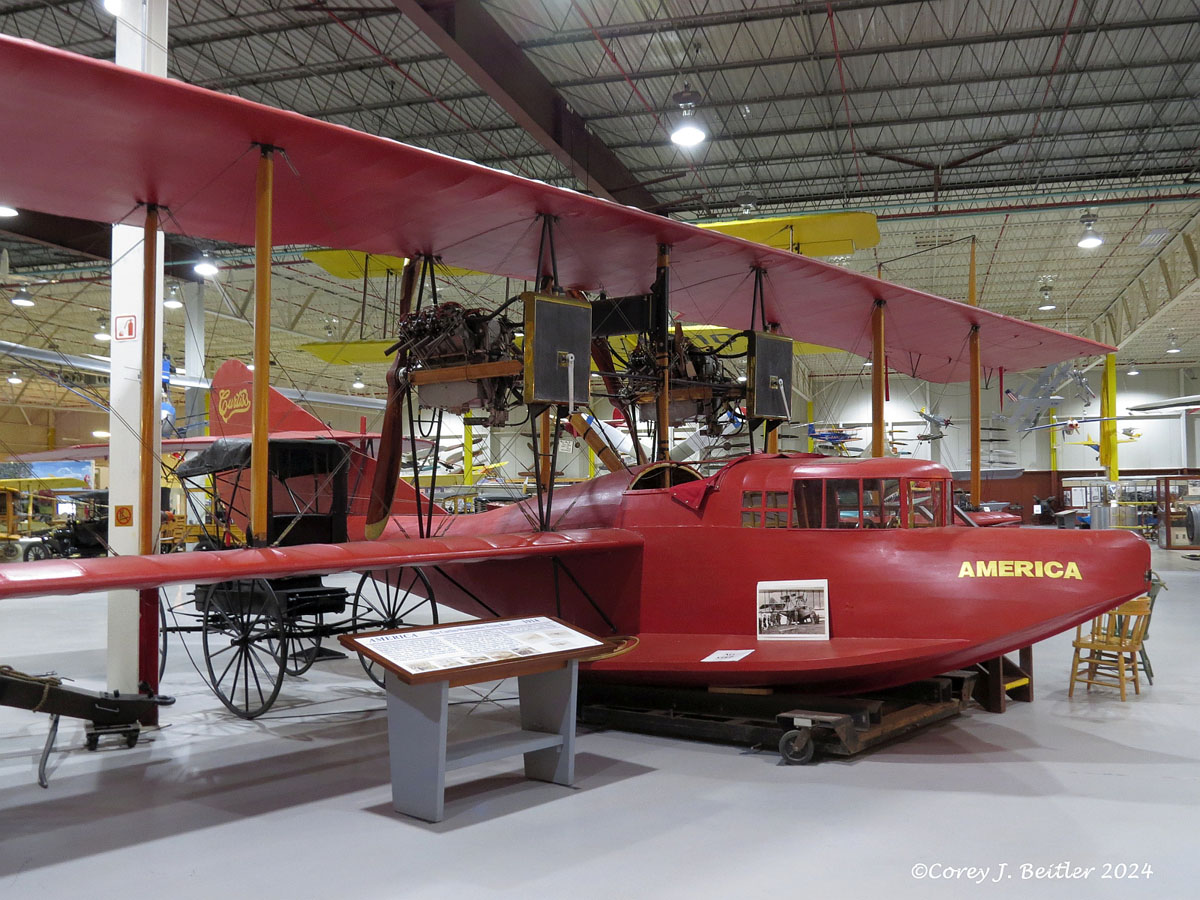
Curtiss America replica
In 1912, Curtiss met retired Royal Navy officer John Cyril Porte. Porte was impressed with the design of Curtiss’ aircraft and was looking for a partner in a venture to build an aircraft capable of completing the first transatlantic crossing and winning a prize offered by the Daily Mail for the achievement. The two men produced an aircraft called the Flying Fish. Unlike the smaller seaplanes designed by Curtiss, the Flying Fish was classified as a flying boat, and its entire fuselage was shaped similarly to the hull of a ship. The aircraft also featured an innovative notch in the hull to help it break clear of the water on takeoff. Curtiss and Porte felt a flying boat configuration was more suitable for building aircraft capable of operating off water and flying long distances. With the backing of investor Rodman Wanamaker, Curtiss and Porte built a larger version of the Flying Fish, a twin-engine flying boat christened America. With a 72-foot wingspan, the America was the largest aircraft designed by Curtiss up to that point in his career. Although America was test-flown several times by Curtiss and Porter on Keuka Lake, World War I broke out before the flying boat could be used for an attempt at a transatlantic crossing.
Porte returned to service with the Royal Navy during the war and arranged to purchase several flying boats similar to the America and designated the H-4, from Curtiss. Porte developed these aircraft further into a range of Felixstowe flying boats capable of being used as coastal patrol and reconnaissance aircraft. Porte passed on the design improvements to Curtiss, who used them to improve his own aircraft designs. The Felixstowe flying boats eventually evolved into a much larger long-range flying boat, the Curtiss H-12, which was the only American-designed and built aircraft to see combat during World War I.
In 1916, Curtiss designed and built the simple, easy-to-fly-and-maintain, two-seat trainer, the JN-4 “Jenny”. The JN-4 was used as a trainer by the U.S. Army. Curtiss created a seaplane version, the N-9, for the U.S. Navy. The “Jenny” became one of the most famous aircraft produced by the Curtiss Aeroplane and Motor Company, with thousands being sold to the militaries of the United States, Canada, and Great Britain. The efforts to build the “Jenny” also employed thousands of people in Curtiss factories in the United States and Canada. After the war ended, many of these “Jennys” were sold as surplus and used for barnstorming and to haul airmail across the country. In 1917, Curtiss designed a long-range flying boat for the U.S. Navy, known as the NC. In 1919, four of these flying boats, with lots of assistance from surface warships from the U.S. Navy, attempted to be the first aircraft to cross the Atlantic Ocean. One of the four aircraft, the NC-4, completed the trip successfully.
The Curtiss Aeroplane and Motor Company underwent a financial reorganization in the 1920s after World War I ended and military contracts were canceled. Curtiss cashed out his stock in the company and retired to Florida. He continued on with the company until his death in 1930, but only as a design advisor. During the 1920s, the company built several purpose-built racing aircraft for the U.S. Army and the U.S. Navy for competition in national and international air races. These sleek racing aircraft helped advance the understanding of high-performance engines and aerodynamics. During this time, Curtiss worked with the U.S. Army, the U.S. Army, and Union Carbide to develop and pioneer the use of ethyl glycol as an engine coolant. Curtiss discovered ethyl glycol cooled engines more efficiently, could withstand higher engine operating temperatures, reduced engine wear and tear, weighed less than water, and did not freeze in cold winter temperatures. Ethyl glycol was eventually developed into use for automobiles as antifreeze.

Curtiss C-46 Commando
In 1929, the Curtiss Aeroplane and Motor Company merged with the Wright Aeronautical Corporation to become Curtiss-Wright. The company continued to produce aircraft and aero engines up until the end of World War II. Notable aircraft designs produced by the company included Robin utility aircraft, the T-32 Condor commercial airliner and executive transport aircraft, the P-6E Hawk, the last biplane fighter ordered by the U.S. Army, the P-40 Warhawk, one of the most important fighter aircraft in the early stages of World War II, the SB2C Helldiver, the last dive bomber built for the U.S. Navy and the C-46 Commando, a large military transport aircraft. The company also had some incredible design failures during the war. A naval scout aircraft, the SO3C Seamew, had so many design problems that the airplane it was supposed to replace, the SOC Seagull, had to be returned to frontline service. A potentially revolutionary high-performance pusher fighter aircraft, the XP-55 Ascender, never made it past the prototype stage and was canceled after two of the prototypes crashed during flight testing. During World War II, cost overruns in designing the Commando and the Helldiver, failures of designs like the SO3C Seamew, and the mismanagement of military contracts led to government investigations of Curtiss-Wright and its management. These investigations eventually led to the company ending its aircraft manufacturing business.
In his retirement, Glenn Curtiss enjoyed hunting and served on several civic commissions in Florida. He helped develop the cities of Hialeah, Miami Springs, and Opa-locka. During his retirement, he designed an elaborate fifth-wheel vehicle called the Aerocar, a forerunner of the modern recreational vehicle. Glenn Curtiss died on July 23, 1930, in Buffalo while traveling to Rochester for a court appearance. During a court hearing, Curtiss suffered an appendicitis attack and died from complications after an emergency appendectomy. He was buried on the family plot in his hometown of Hammondsport.

Vintage motorcycles
Today, the Glenn H. Curtiss Museum has several exhibits that honor the fascinating life of the aviation pioneer and his achievements. One of the highlights of the exhibits is a large collection of early bicycles and motorcycles designed by Curtiss and some of his business associates. Some of these early motorcycles are cleverly displayed in a facade that resembles the Curtiss bicycle shop in Hammondsport in the early 1900s. Displayed near these motorcycles is a full-size reproduction of the June Bug, the first aircraft designed by Curtiss. Informative placards detail the history of the AEA and the efforts by Curtiss to build and fly the June Bug.
Another highlight of the exhibitions in the museum is an authentic Curtiss JN-4 “Jenny” trainer. This “Jenny” was found by the museum and restored to static display condition for exhibition. The “Jenny” is restored in World War I U.S. Army colors. In addition to building and designing airplanes, Glenn Curtiss also operated several flight schools, with two of the largest being in Hammondsport and San Diego. Curtiss believed that anyone could learn to fly and thousands of pilots were trained at flight schools owned by Curtiss. Two aircraft on display in the museum that highlight his contributions to flight training are a Curtiss Oriole biplane and a Standard J-1 biplane, two types that were widely used as training aircraft during the 1920s.
The Glenn H. Curtiss Museum staff has also built reproduction aircraft for display in museum exhibits, including examples of several of the early flying boats and seaplanes designed and flown by Curtiss. One of the more impressive aircraft built by museum volunteers is a reproduction of the 1914 America flying boat. This reproduction was built following the original plans drawn by Curtiss and Porte and was completed in 2007. After extensive testing, this reproduction was flown off Keuka Lake in 2008, just like Glenn Curtiss and John Cyril Porte did with the original in 1914.

Curtiss small artifacts
Other smaller exhibits throughout the Glenn H. Curtiss Museum tell the story of the aviation pioneer, his achievements, and other landmark moments in aviation history. Smaller display cases hold dozens of items of aviation memorabilia that include ticket stubs from early aviation exhibitions, pennants, buttons, ribbons, commemorative dishware, and more. Other display cases hold smaller items such as flight helmets, flying goggles, gloves, pilot log books, and small airplane parts. Historical photographs and artwork of Curtiss and his aircraft fill museum walls and exhibit areas. To help tell the story of aviation history within the museum, several large-scale models of historical aircraft from World War I and World War II hang from the ceiling.
Another unique exhibition on display in the museum is a recreation of the office cupola that was attached to the Glenn Curtiss home. The recreation of this office cupola gives museum visitors a unique opportunity to look inside the life oft he aviation pioneer as he designed his aircraft and conducted business. The office is recreated from historical photos and includes vintage furniture, a beautiful vintage globe, models of aircraft hanging from the ceiling, reference books, vintage photographs on the wall, and aircraft models hanging from the ceiling. The only addition that would make the office cupola more realistic would be Glenn Curtiss sitting at the desk drawing the designs for one of his airplanes.

Mercury S4 racer
In addition to honoring the legacy of Glenn Curtiss, the museum also honors the history of another local aircraft manufacturer. Mercury Aircraft was established in 1920 in Hammondsport and always had a close relationship with the Curtiss Aeroplane and Motor Company. The company sold surplus parts for Curtiss “Jennys”, along with radios and other aircraft components. The company also designed and built small numbers of its own aircraft. The Mercury Aircraft exhibit in the Glenn H. Curtiss Museum includes the Mercury S-4 Racing Aircraft, several historic photographs of Mercury Aircraft designs, and a model of the aluminum school buses built by Mercury Aircraft in the late 1940s. Mercury remains in business today as a metal fabricator and is a generous supporter of the Glenn H. Curtiss Museum, donating funding and materials for many of the museum’s restoration projects.
The museum also has a few aircraft on display that were not designed by Glenn Curtiss. One of these aircraft is a reproduction of a Royal Aircraft S.E.5a fighter aircraft from World War I. Introduced in 1917, the fast and highly maneuverable S.E.5a is widely regarded as one of the best British fighter aircraft of World War I. Over 5,000 S.E.5as were built during World War I and they were used by the Royal Flying Corps, the Royal Australian Air Force, the Royal Canadian Air Force, and the United States Army Air Service.
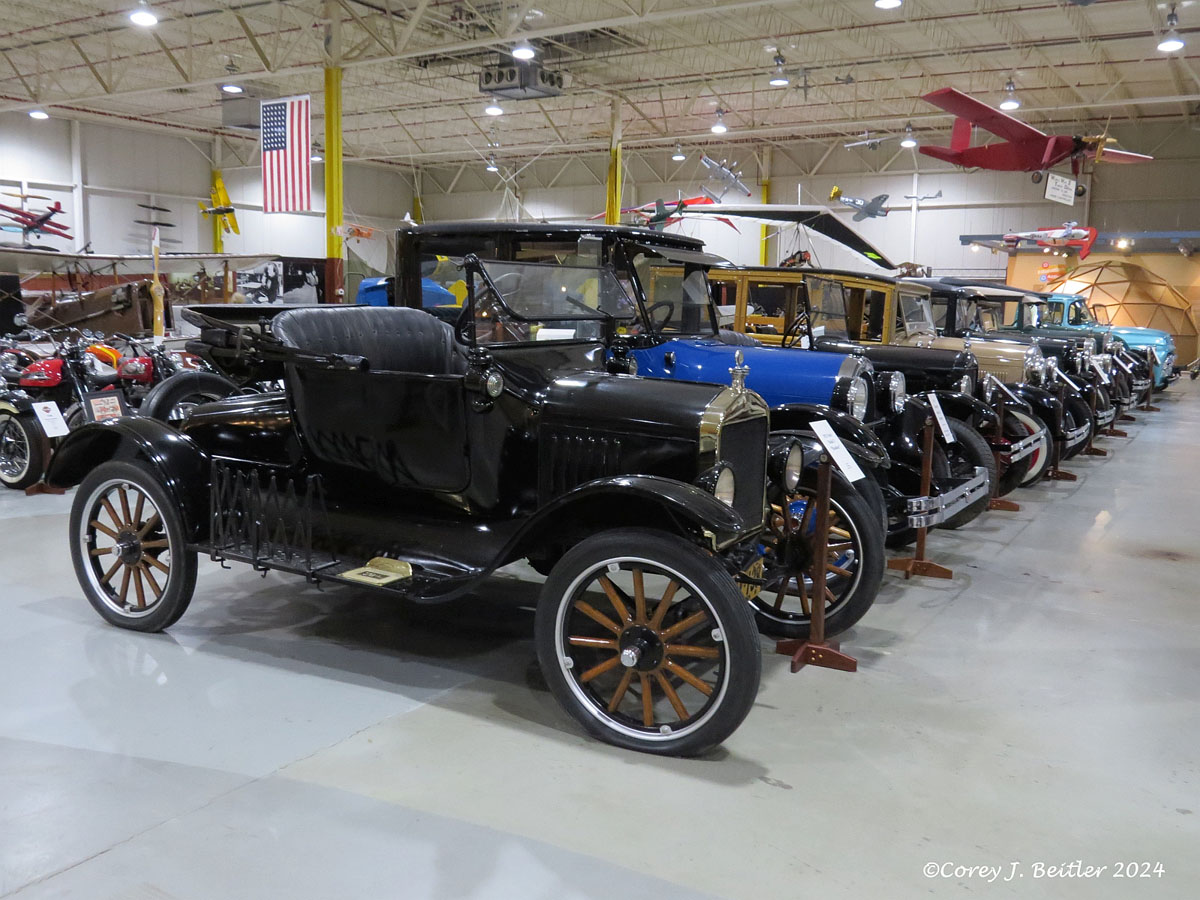
Vintage automobiles
The Glenn H. Curtiss Museum also includes other historical exhibitions related to transportation in Hammondsport and the Finger Lakes region. The museum displays a large collection of vintage automobiles and motorcycles. Most of these automobiles and motorcycles are on loan from private individuals and help fill out display space on the museum floor. Another museum exhibition has examples of early fire equipment, including horse-drawn fire engines, used by some of the first firefighters in the town of Hammondsport and other communities in the Finger Lakes.
The Glenn H. Curtiss Museum is an amazing place to visit for anyone interested in transportation, especially aviation enthusiasts. It is also a great place to stop and spend a few hours when visiting the Finger Lakes region of Western New York. The museum has a wonderful collection of authentic and reproduction aircraft, bicycles and motorcycles, and other artifacts that chronicle the life of the man who played an important part in the formation of the aviation industry in the United States and was one of the most innovative Americans of his time. More information about the museum, including admission costs, operating hours, its exhibits, and a calendar of special events, can be found at the museum’s website, https://glennhcurtissmuseum.org/





